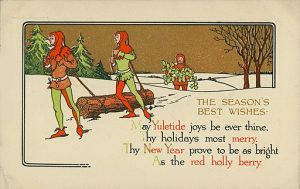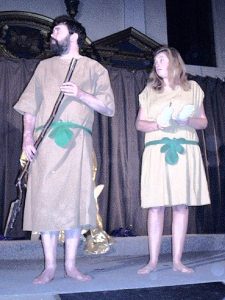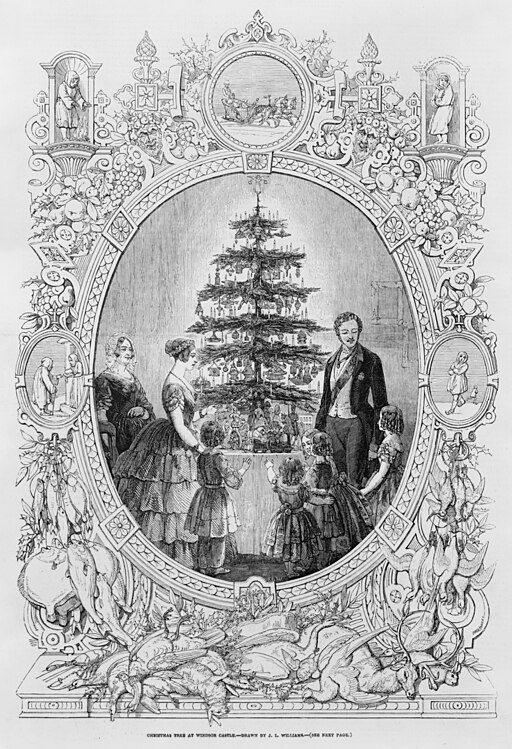Christmas trees appear in so many happy childhood memories that it can be amazing to learn how old they are. From an old Germanic tradition, Christmas trees first appeared in the Middle Ages and spread across Europe. Later, German immigrants carried this custom to their newfound home in America. As time went on, many Americans put their own marks on the tradition, from growing thousands of trees on farms each year to creating the memorable aluminum Christmas trees. Join us for a celebration of the history of Christmas trees, and check out CRRL’s collection for books about this beloved holiday tradition!
Books and more on Christmas decorating traditions and how-to guides for decking the halls, including Christmas tree ornaments.
Christmas Tree History: A Snapshot
- From the Germanic tradition, Christmas trees first appeared in the Middle Ages. The Feast Day of Adam and Eve was celebrated with Paradise plays, in which the tree from the Garden of Eden was represented by a fir tree decorated with apples.
- Christmas trees appeared in Britain and America much later, first as a custom of the nobility in the early 1800s, and, by the 1900s, they were a popular tradition across all social classes.
- Eventually, Christmas trees found a home in America, brought by German immigrants in the early 19th century. Americans put their own mark on the tradition with Christmas tree farms (first opened in New Jersey in 1901) and manufacturing aluminum Christmas trees.
Read on for more fun facts about the history of Christmas trees, and check out CRRL’s collection for books about this beloved holiday tradition!
A Gift From Germanic Culture
The concept of a Christmas tree has its roots in Germanic culture. The oldest precursor to the Christmas tree may be the Yule log, opens a new window, a tradition associated with Scandinavia and northern Europe. A Yule log is a large log burned in the fireplace on Christmas Eve. This tradition predates Christianity and was rooted in Germanic paganism. Originally it celebrated the winter solstice, opens a new window, the shortest day of the year, which usually takes place on December 21 or 22. Since the days would begin to get longer after the winter solstice, it was seen as a time of rebirth. The warmth of the log on the fire and the light from it represented the end of the growing darkness and reminded people that longer, warmer days awaited them. Although Christianity changed the day of the winter celebration to December 25, the Yule log tradition remains popular in Europe (and the United States) up to the present day., opens a new window
The modern concept of a decorated Christmas tree is believed to come from medieval Germany and Christian tradition. The concept likely originated from the performance of Paradise plays, opens a new window, which portrayed Adam and Eve’s fall from Grace. These plays were always performed on December 24 (the feast day of Adam and Eve) and represented the tree in the Garden of Eden with a fir tree, opens a new window decorated with apples. As the decorated tree began to become associated with the Christmas holiday, the Christmas tree would soon move beyond the play itself.
By the Renaissance, guilds had begun to put up Christmas trees in celebration of the holiday. In 1419, opens a new window, the Baker’s Guild in Freiburg, Germany, put up a Christmas tree decorated with sweets for the children of the guild members. Public displays of trees became popular in Germany over the years. A guild from Bremen, Germany referenced having a tree decorated, opens a new window in “apples, nuts, pretzels, and paper flowers” in its guild hall in 1570. Another early center of Christmas trees was Riga, in present-day Latvia. Riga was an early adopter, opens a new window of Christmas trees and displays a marker in its town hall square claiming to have had the first one. Their account says that the first Christmas tree was set up in Riga by a merchant’s guild called the Brotherhood of the Blackheads in 1510. Like the other cities mentioned here, Riga had substantial German influence, opens a new window during the medieval period.
Christmas Trees in Britain and America
Although these accounts of early Christmas trees are so old they may be more legend than fact, they do support the idea that early Christmas trees come from the Germanic tradition. Christmas trees only started to appear in English-speaking countries much later, first as a custom of the nobility. The first Christmas tree in Britain came from the German-born Queen Charlotte, opens a new window, who decorated the tree in 1800. The young Queen Victoria, opens a new window enjoyed seeing this tree as a teenager and would go on to make it a popular custom across Britain with her husband Prince Albert’s help. Albert, opens a new window was also German-born and enjoyed the Christmas tree custom so much that he sent decorated trees to army barracks and schools in Windsor.
An engraving, opens a new window published in 1848 by the Illustrated London News helped to popularize Christmas trees among wealthier British families. The depiction of the royal family together around the tree gave Christmas trees a sentimental, romantic appeal to Britain’s upper class, who rapidly adopted the custom in less than 10 years. Less wealthy families took longer to adopt the custom, but public events and spending brought the tradition to them as well. By 1906, opens a new window, the Poor Children’s Yuletide Association had raised funds to put 71 Christmas trees in London’s poorest slums, allowing even the poorest British children to experience Christmas trees. From there on, the tradition became popular across all social classes in Britain, and today remains a staple of British culture.
The early 19th century also marked the introduction of the Christmas tree to the United States. As in Britain, the Christmas tree was originally popularized in the U.S. by Germanic people, with early references including the 1836 frontispiece of The Stranger’s Gift,, opens a new window by Herman Bokum. Areas heavily populated by German immigrants, such as Pennsylvania, were the first places the custom became popular; New England, with its Puritan cultural heritage, took longer. Some German settlements in Pennsylvania, opens a new window may have had community trees as early as 1747, opens a new window! But it would take until the second half of the 19th century for the tradition to become popular in other parts of the country. In 1851, opens a new window, Mark Carr set up the first Christmas tree market in the United States in New York’s Catskill Mountains, and the industry of Christmas trees in our country began.
Of Wood and Aluminum: Christmas Trees in the 20th Century
50 years after Mark Carr’s first market, an actual Christmas tree farm would open in the United States. In 1901, W.V. McGalliard, opens a new window, a farmer in New Jersey, planted 25,000 Norway spruce on his farm in hopes of making money off the Christmas season. His venture proved so successful that Christmas tree farms rapidly appeared in every state. Part of the appeal of the Christmas tree farm was that much deforestation, opens a new window had already taken place by the early 1900s, making it harder to find a good tree in the forest…or even a natural forest at all. Christmas tree farms made high quality trees available to many American families. Eventually the tree farm industry became dominated by Oregon, opens a new window and North Carolina tree farms, although several other states have notable industries. Virginia’s production of Christmas trees is 7th highest in the nation!
Artificial Christmas trees also gained a foothold in the market, with some peaks and valleys in their popularity. Many people now only remember “aluminum Christmas trees” as a punchline from A Charlie Brown Christmas, opens a new window, but these trees were actually quite popular for a time during the late 1950s and early 1960s. Aluminum Christmas trees were mostly made in Manitowoc, Wisconsin, opens a new window. In 1958, the toy sales manager for the Aluminum Specialty Company found a metal Christmas tree in a sales window that caught his eye, but thought it was too expensive and difficult to assemble. Aluminum Specialty engineers managed to create a much cheaper and easier to assemble tree in three months, opens a new window, getting it ready for the Christmas of 1959.
The trees were called “Evergleams” and were not advertised as “artificial” trees, though their space-age appearance and unique color schemes were a selling point. Evergleams remained popular until 1965, when A Charlie Brown Christmas made them seem like a symbol of commercial excess. Aluminum tree sales never recovered, and Aluminum Specialty ceased making them around 1971-1972, opens a new window. Over the decades, aluminum trees regained a cult popularity, and Manitowoc began to display many of the vintage Evergleams in its seasonal display, Evergleams on Eighth, opens a new window. Even a metal tree can become a warm symbol of nostalgia and merry Christmases past when we take the time to remember the happy times with our families.
Today, you have your choice of trees. Evergreen or ever-white artificial or natural to plant or mulch afterward. Different kinds, from fir to spruce to pine to cedar. Sizes from a tiny tabletop model to trees to big enough to fill a room with a cathedral ceiling. Whatever your tree and however you decorate, you'll be celebrating the season with a sprig of history.






